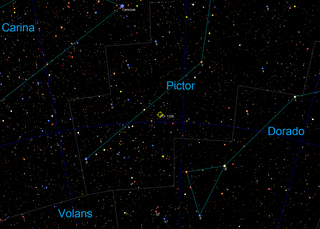TOI 1338
|
Star TOI 1338 |
|||||
|---|---|---|---|---|---|

|
|||||
| The position of the TOI 1338 star system in the painter constellation | |||||
| AladinLite | |||||
|
Observation dates equinox : J2000.0 , epoch : J2000.0 |
|||||
| Constellation | painter | ||||
| Right ascension | 06 h 08 m 31.94 s | ||||
| declination | -59 ° 32 ′ 27.6 ″ | ||||
| Apparent brightness | 11.975 ± 0.025 mag | ||||
| Typing | |||||
| Known exoplanets | 1 | ||||
| Astrometry | |||||
| Radial velocity | 24.68 ± 8.08 km / s | ||||
| parallax | 2.4774 ± 0.0196 mas | ||||
| distance | 1300 Lj 398.58 pc |
||||
| Proper movement | |||||
| Rec. Share: | -12,258 ± 0.037 mas / a | ||||
| Dec. portion: | 34,405 ± 0.041 mas / a | ||||
| Physical Properties | |||||
| radius | 3.1 ± 0.38 R ☉ | ||||
| Effective temperature | 5723.0 (± 110.0) K. | ||||
| Metallicity [Fe / H] | -0.4 ± 0.1 | ||||
|
Other names and catalog entries |
|||||
|
|||||
TOI 1338 is a binary star system in the constellation Maler , which is orbited by a planet. The discovery was made using data collected by the TESS space telescope . Wolf Cukier, a student at Scarsdale High School in Scarsdale , recognized her as the signature of an exoplanet during the third day of his 2019 summer internship at NASA's Goddard Space Flight Center . The system is approximately 1,300 light years from the solar system. It consists of a star TOI 1338 A with 1.2 solar masses , which is orbited by another star TOI 1338 B with 0.325 solar masses in 14.6 days. The center of mass of both stars is orbited by the circumbinary exoplanet TOI 1338b within 71.4 (± 0.13) days. According to the measurements by TESS, the exoplanet TOI 1338b has a mass of 6.5 Earth masses . NASA published the discovery on its homepage on January 7, 2020. Due to its southern location, the TOI 1338 system cannot be seen from Germany, although the main star with an apparent magnitude of 12 may be bright enough for a telescope with an aperture of 200 mm is.
designation
The acronym "TOI" is used to designate stars and exoplanets that have been studied by TESS. It is short for "Transiting Exoplanet Survey Satellite Object of Interest". The main star of the system is also listed in the databases 2MASS (J06083197-5932280), Tycho-2 catalog (TYC 8533-950-1), RAVE (J060832.0-593228) and GAIA .
Individual evidence
- ↑ a b c TYC 8533-950-1. In: SIMBAD . Center de Données astronomiques de Strasbourg , accessed January 12, 2020 .
- ↑ a b c d Gaia Collaboration: Gaia Data Release 2 - Summary of the contents and survey properties . In: Astronomy & Astrophysics . 616, August 1, 2018, ISSN 0004-6361 , p. A1. doi : 10.1051 / 0004-6361 / 201833051 .
- ↑ a b c d TOI 1338. In: Extrasolar Planets Encyclopaedia . Retrieved January 12, 2020 .
- ↑ Jetzt.de: "A student intern at NASA has discovered a planet" (accessed on January 12, 2020)
- ↑ a b Jeanette Kazmierczak: NASA's TESS Mission Uncovers Its 1st World With Two Stars. NASA.gov. January 7, 2020, accessed January 12, 2020.
- ↑ Martin et al .: The BEBOP radial-velocity survey for circumbinary planets , Astronomy & Astrophysics, January 8, 2019
- ^ TOI 1338. In: Exoplanet Follow-up Observing Program for TESS. Retrieved January 28, 2020 .
- ↑ SIMBAD TYC 8533-950-1 (accessed January 12, 2020)
literature
- Martin, Amaury, Udry, Marmier, Maxted, Cameron, Hellier, Pepe, Pollacco, Segransan, West: The BEBOP radial-velocity survey for circumbinary planets - I. Eight years of CORALIE observations of 47 single-line eclipsing binaries and abundance constraints on the masses of circumbinary planets , Astronomy & Astrophysics, January 8, 2019 ( online )